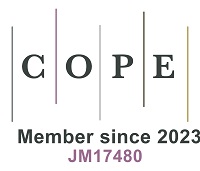REFERENCES
1. Bhaskar, R.; Frank, C.; Høyer, K. G.; Naess, P.; Parker, J. Interdisciplinarity and climate change: transforming knowledge and practice for our global future. Abingdon, Oxon New York: Routledge; 2010.
2. Friedmann, J. The uses of planning theory: a bibliographic essay. J. Plan. Educ. Res. 2008, 28, 247-57.
3. LeGates, R. T.; Stout, F. The city reader, Seventh edition. In: Routledge urban reader series. London; New York: Routledge; 2020.
4. Hautamäki, R.; Puustinen, T.; Merikoski, T.; Staffans, A. Greening the compact city: unarticulated tensions and incremental advances in municipal climate action plans. Cities 2024, 152, 105251.
5. Säynäjoki, E.; Heinonen, J.; Junnila, S. The power of urban planning on environmental sustainability: a focus group study in Finland. Sustainability 2014, 6, 6622-43.
6. Lähde, E.; Kemppainen, M.; Lahtinen, E.; Jama, T.; Mahlio, O. Kaupunkisuunnittelun biodiversiteettikäänne 2020-luvulla. Yhdyskuntasuunnittelu 2025, 62, 14-40.
7. Balikçi, S.; Giezen, M.; Arundel, R. The paradox of planning the compact and green city: analyzing land-use change in Amsterdam and Brussels. J. Environ. Plan. Manag. 2022, 65, 2387-411.
8. Berghauser Pont, M.; Haupt, P.; Berg, P.; Alstäde, V.; Heyman, A. Systematic review and comparison of densification effects and planning motivations. Build. Cities. 2021, 2, 378.
9. Creutzig, F.; Mcphearson, T.; Bardhan, R.; et al. Bridging the scale between the local particular and the global universal in climate change assessments of cities. Nat. Cities. 2025, 2, 369-78.
10. Batty, M.; Marshall, S. Centenary paper: the evolution of cities: Geddes, Abercrombie and the new physicalism. Town. Plan. Rev. 2009, 80, 551-74.
11. Lehnerer, A. Grand urban rules. Rotterdam: 010 Publishers; 2009. Available from: https://www.nai010.com/product/grand-urban-rules/ [Last accessed on 11 Aug 2025].
12. Albrechts, L. Breaking out of the box: ingredients for a more radical planning. Procedia 2015, 184, 104-10.
14. Peck, J. Economic rationality meets celebrity urbanology: exploring Edward Glaeser's city: economic rationality meets celebrity urbanology. Int. J. Urban. Regional. Res. 2016, 40, 1-30.
15. Zhao, M.; Cheng, C.; Zhou, Y.; Li, X.; Shen, S.; Song, C. A global dataset of annual urban extents (1992-2020) from harmonized nighttime lights. Earth. Syst. Sci. Data. 2022, 14, 517-34.
16. IPCC. Urban systems and other settlements. In: Climate change 2022 - mitigation of climate change. Cambridge University Press; 2023. pp. 861-952.
17. Ripple, W. J.; Wolf, C.; Gregg, J. W.; et al. The 2024 state of the climate report: perilous times on planet Earth. BioScience 2024, 74, 812-24.
18. Friedlingstein, P.; O'sullivan, M.; Jones, M. W.; et al. Global carbon budget 2024. Earth. Syst. Sci. Data. 2025, 17, 965-1039.
19. Müller, D. B.; Liu, G.; Løvik, A. N.; et al. Carbon emissions of infrastructure development. Environ. Sci. Technol. 2013, 47, 11739-46.
20. Smith, S. The world needs to build 2 billion new homes over the next 80 years. World Economic Forum; 2018. Available from: https://www.weforum.org/stories/2018/03/the-world-needs-to-build-more-than-two-billion-new-homes-over-the-next-80-years/ [Last accessed on 6 Aug 2025].
21. Erickson, P.; Tempest, K. Keeping cities green: Avoiding carbon lock-in due to urban development. SEI Working Paper No. 2015-11. Available from: https://www.sei.org/publications/keeping-cities-green-avoiding-carbon-lock-in-due-to-urban-development/ [Last accessed on 6 Aug 2025].
22. De Giorgi, G.; Moretti, E.; Wheeler, H. Gentrification, mobility, and consumption. arXiv 2024, 2407.06695.
23. Glaeser, E. L. Triumph of the city: how our greatest invention makes us richer, smarter, greener, healthier, and happier. New York, NY: Penguin Books; 2012.
24. Glaeser, E. L.; Cutler, D. Survival of the city: living and thriving in an age of isolation. Penguin; 2022. Available from: https://www.penguinrandomhouse.com/books/669805/survival-of-the-city-by-edward-glaeser-and-david-cutler/ [Last accessed on 11 Aug 2025].
27. Heinonen, J.; Jalas, M.; Juntunen, J. K.; Ala-Mantila, S.; Junnila, S. Situated lifestyles: II. the impacts of urban density, housing type and motorization on the greenhouse gas emissions of the middle-income consumers in Finland. Environ. Res. Lett. 2013, 8, 035050.
28. Zhu, K.; Tu, M.; Li, Y. Did polycentric and compact structure reduce carbon emissions? A spatial panel data analysis of 286 Chinese cities from 2002 to 2019. Land 2022, 11, 185.
29. Ferreira, A.; Batey, P. On why planning should not reinforce self-reinforcing trends: a cautionary analysis of the compact-city proposal applied to large cities. Environ. Plan. B. Plan. Des. 2011, 38, 231-47.
30. Wachsmuth, D.; Cohen, D. A.; Angelo, H. Expand the frontiers of urban sustainability. Nature 2016, 536, 391-3.
31. Moran, D.; Kanemoto, K.; Jiborn, M.; Wood, R.; Többen, J.; Seto, K. C. Carbon footprints of 13 000 cities. Environ. Res. Lett. 2018, 13, 064041.
32. Wiedenhofer, D.; Guan, D.; Liu, Z.; Meng, J.; Zhang, N.; Wei, Y. Unequal household carbon footprints in China. Nature. Clim. Chang. 2017, 7, 75-80.
33. Carta, S. Machine learning and the city: applications in architecture and urban design, 1st ed. John Wiley & Sons Ltd.; 2022.
34. Jay, S.; Jones, C.; Slinn, P.; Wood, C. Environmental impact assessment: retrospect and prospect. Environ. Impact. Assess. Rev. 2007, 27, 287-300.
35. Lylykangas, K.; Cachia, R.; Cerrone, D.; et al. Territorial and consumption-based greenhouse gas emissions assessments: implications for spatial planning policies. Land 2023, 12, 1144.
36. Amiri, A.; Emami, N.; Ottelin, J.; et al. Embodied emissions of buildings - A forgotten factor in green building certificates. Energy. Build. 2021, 241, 110962.
38. Bhaskar, R. A realist theory of science. In: Classical texts in critical realism. London: Routledge; 2015.
41. Valsson, T. City and nature: an integrated whole. Reykjavík: Háskólaútgáfan; 2000.
42. Hautamäki, R. From sparse to compact city - shifting notions of nature in post-war residential landscapes in the Helsinki region. Plan. Perspect. 2022, 37, 1179-203.
43. Jensen, D.; Keith, L.; Wilbert, M. Bright green lies: how the environmental movement lost its way and what we can do about it. In: Politics of the living series. Rhinebeck, New York: Monkfish Book Publishing Company; 2021.
44. Jama, T.; Tenkanen, H.; Lönnqvist, H.; Joutsiniemi, A. Compact city and urban planning: correlation between density and local amenities. Environ. Plan. B. Urban. 2025, 52, 44-58.
45. European Environment Agency and European Commission. Urban sprawl in Europe - The ignored challenge. EEA report, no. 10/2006; Copenhagen, Denmark: European Environment Agency; Luxembourg: Office for Official Publications of the European Communities; 2006. Available from: https://www.eea.europa.eu/publications/eea_report_2006_10/eea_report_10_2006.pdf/view [Last accessed on 11 Aug 2025].
46. European Environment Agency; Swiss Federal Office for the Environment (FOEN). Urban sprawl in Europe: joint EEA-FOEN report. LU: Publications Office; 2016. Available from: https://data.europa.eu/doi/10.2800/143470 [Last accessed on 6 Aug 2025].
47. Mayne, T. Opinion: adding 1 million people along the Wilshire corridor could help L.A. create a sustainable city. Available from: https://www.latimes.com/opinion/livable-city/la-ol-thom-mayne-climate-change-density-newhall-ranch-20161103-story.html [Last accessed on 6 Aug 2025].
48. UN Habitat. A new strategy of sustainable neighbourhood planning: five principles; 2014. Available from: https://unhabitat.org/sites/default/files/documents/2019-05/five_principles_of_sustainable_neighborhood_planning.pdf [Last accessed on 6 Aug 2025].
49. Page, M.; Joutsiniemi, A.; Vaattovaara, M.; Jama, T.; Rönnberg, O. Density as an indicator of sustainable urban development: insights from Helsinki? Eur. Plan. Stud. 2024, 32, 2182-202.
50. Berghauser, P. M.; Haupt, P. Spacematrix: space, density and urban form. Rotterdam: Nai010 Publishers; 2021.
51. Elmqvist, T. Urbanization, biodiversity and ecosystem services: challenges and opportunities: a global assessment; A part of the cities and biodiversity outlook project. Dordrecht Heidelberg: Springer, 2013.
52. Banitz, T.; Hertz, T.; Johansson, L. G.; et al. Visualization of causation in social-ecological systems. Ecol. Soc. 2022, 27, 31.
53. Tratalos, J.; Fuller, R. A.; Warren, P. H.; Davies, R. G.; Gaston, K. J. Urban form, biodiversity potential and ecosystem services. Landsc. Urban. Plan. 2007, 83, 308-17.
54. Kroft, L. E.; Ziter, C. D. The effects of urban density on the provision of multiple health-related ecosystem services. Urban. Ecosyst. 2024, 27, 491-513.
55. Cole, R. J. Transition to a regenerative future: a question of time. Build. Cities. 2023, 4, 457-74.
56. Zari, M. P. Regenerative urban design and ecosystem biomimicry, 1st ed. London: Routledge, 2018.
57. du Plessis, C. Towards a regenerative paradigm for the built environment. Build. Res. Inf. 2012, 40, 7-22.
59. Isaksen K. Reclaiming rational theory choice as central: a critique of methodological applications of critical realism. J. Crit. Realism. 2016, 15, 245-62.
60. Churkina, G.; Organschi, A.; Reyer, C. P. O.; et al. Buildings as a global carbon sink. Nat. Sustain. 2020, 3, 269-76.
61. Kinnunen, A.; Lampinen, J. Urban biodiversity and carbon sinks - do they overlap? Case study of Helsinki Metropolitan Area, Finland. IOP. Conf. Ser. Earth. Environ. Sci. 2022, 1101, 022005.
62. Talvitie, I.; Kinnunen, A.; Amiri, A.; Junnila, S. Can future cities grow a carbon storage equal to forests? Environ. Res. Lett. 2023, 18, 044029.
63. Klaasen, I. T. Knowledge-based design: developing urban & regional design into a science. Delft: Delft University Press, 2004.
64. Kornberger, M. Governing the city: from planning to urban strategy. Theor. Cult. Soc. 2012, 29, 84-106.
65. Bjånesøy, S.; Kinnunen, A.; Einarsdóttir, H.; Heinonen, J. Carbon storage in the built environment: a review. Environ. Res. Infrastruct. Sustain. 2023, 3, 042003.
66. Kuittinen, M.; Zernicke, C.; Slabik, S.; Hafner, A. How can carbon be stored in the built environment? A review of potential options. Archit. Sci. Rev. 2023, 66, 91-107.
67. Malabi Eberhardt, L. C.; Kuittinen, M.; Häkkinen, T.; Moinel, C.; Nibel, S.; Birgisdottir, H. Carbon handprint - a review of potential climate benefits of buildings. Build. Res. Inf. 2024, 52, 708-23.
68. Leppänen, P.; Kinnunen, A.; Hautamäki, R.; et al. Impact of changing urban typologies on residential vegetation and its climate-effects - A case study from Helsinki, Finland. Urban. For. Urban. Gree. 2024, 96, 128343.
69. Espoo. “Espoo’s online map service. Available from: https://kartat.espoo.fi/IMS/en/Map [Last accessed on 6 Aug 2025].
70. Heinilä, A. Suunnittelutarve- ja poikkeamispäätösmenettelyjen toimivuus. Ministry of Environment, Helsinki, 2014. Available from: https://julkaisut.valtioneuvosto.fi/bitstream/handle/10138/42612/YMra_1_2014.pdf [Last accessed on 6 Aug 2025].
71. Geels, F. W. Socio-technical transitions to sustainability: a review of criticisms and elaborations of the multi-level perspective. Cur. Opin. Environ. Sustain. 2019, 39, 187-201.
72. Glaeser, E. L. The economics approach to cities. National Bureau of Economic Research, 2007. Available from: https://www.nber.org/system/files/working_papers/w13696/w13696.pdf [Last accessed on 11 Aug 2025].
73. Vimpari, J.; Junnila, S. Theory of valuing building life-cycle investments. Build. Res. Inf. 2016, 44, 345-57.
74. Hillier, B. Space is the machine: a configurational theory of architecture. London: Space Syntax; 2015. Available from: https://discovery.ucl.ac.uk/id/eprint/3881 [Last accessed on 11 Aug 2025].
75. Richardson, K.; Steffen, W.; Lucht, W.; et al. Earth beyond six of nine planetary boundaries. Sci. Adv. 2023, 9, eadh2458.








